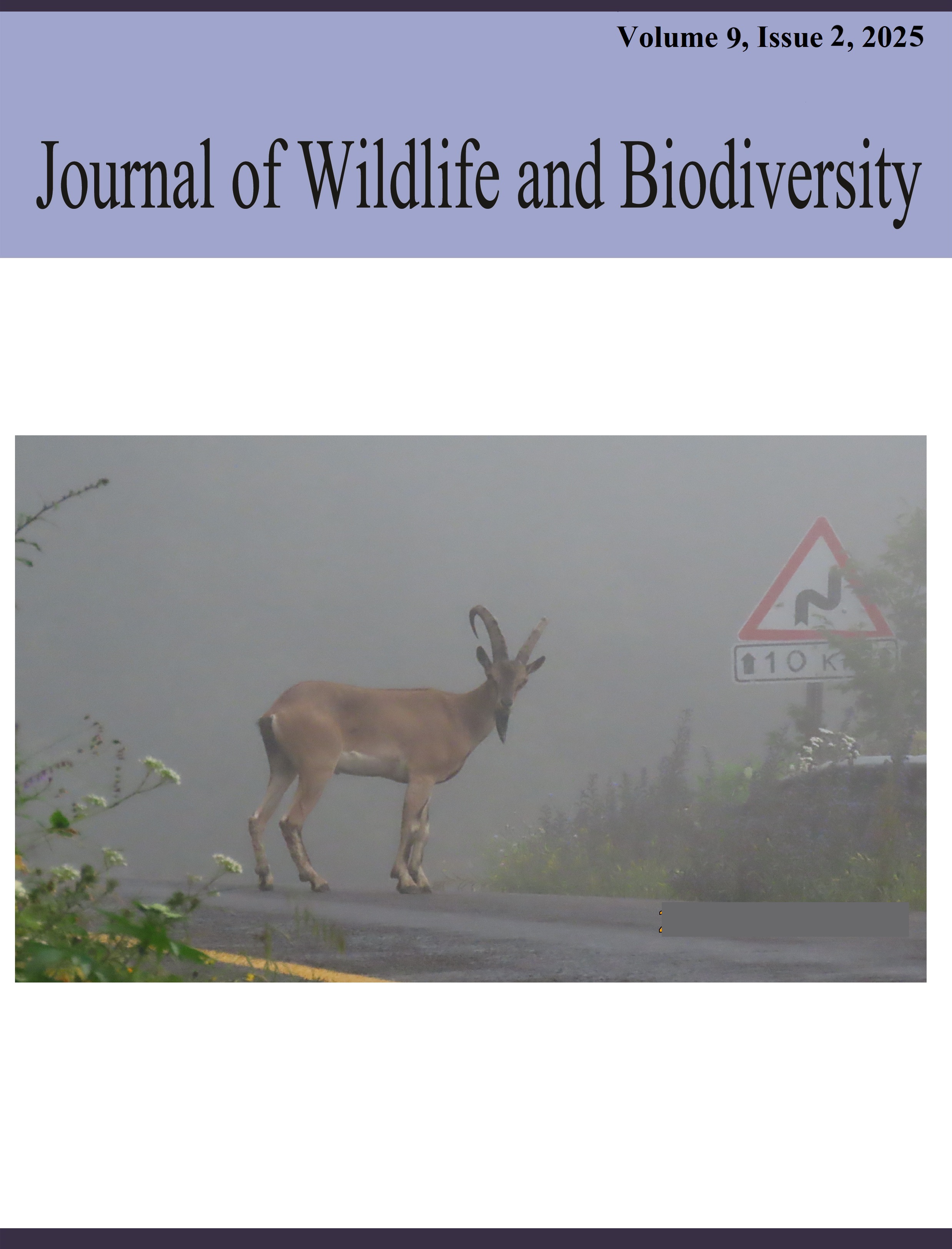Multifactorial ANOVA analysis of genotype and environment effects on morphological and agronomic traits in G. barbadense L. cotton
DOI:
https://doi.org/10.5281/zenodo.15521377Keywords:
G. barbadense L., stress, drought, yield attributes, selectionAbstract
This study investigates the influence of genotype and environmental stress (optimal, drought, and salinity conditions) on morphological and agronomic traits in ten fine-fiber cotton genotypes using multifactorial ANOVA. Traits such as plant height, number of fruiting branches, number of opened bolls, total boll number, boll weight, vegetative period, and overall yield were analyzed. Results showed that genotype had no statistically significant effect on most traits (P > 0.05), whereas environmental factors significantly impacted all studied parameters (P < 0.0001 in most cases). Genotypes such as T-2024, Duru-gavhar-4 (T-5560), Angor (T-1981), and T-2090 demonstrated relative stability and adaptability to stress conditions and may be considered valuable in breeding programs for stress-tolerant cotton cultivars.
References
Akinwale, M. G., Gregorio, G., Nwilene, F., Akinyele, B. O., Ogunbayo, S. A., & Odiyi, A. C. (2014). Heritability and correlation coefficient analysis for yield and its components in rice (Oryza sativa L.). African Journal of Plant Science, 5(3), 207-212.
Ali, A., et al. (2021). Evaluation of cotton genotypes under salinity stress for yield and fiber quality traits. Plant Stress, 2, 100041.
Ashraf, M., & Foolad, M. R. (2007). Roles of glycine betaine and proline in improving plant abiotic stress resistance. Environmental and Experimental Botany, 59(2), 206-216.
Azimov, A., Aliqulov, E.,Ergashev, O., Shavkiev, J. (2024a).Estimation of dominance and heterosis of morpho-economic traits in intraspecific F1 hybrids of upland cotton, Journal of Wildlife and Biodiversity, 8(3), 162-174. https://doi.org/10.5281/zenodo.11409018
Azimov, A., Shavkiev, J., Ahmedjanov, A.,, Temirova Y., Koraev, A., Nurmetov, Kh., Rasulova, O. (2024b). Genetic analysis and inbreeding depression for yield-related parameters in upland cotton. SABRAO Journal of Breeding and Genetics, 56(4), 1345-1356. http://doi.org/10.54910/sabrao2024.56.4.2.
Azimov, A., Shavkiev, J., Nabiev, S., Khamdullaev, S., Pulatov, S., Rajabov, Z. (2024c). Cobalt-60-γ-radiation effect on morpho-yield and earliness traits in colored cotton (Gossypium hirsutum L.). SABRAO Journal of Breeding and Genetics, 56(6), 2248-2259. http://doi.org/10.54910/sabrao2024.56.6.7.
Chorshanbiev, N.E., Nabiev, S.M., Azimov, A.A., Shavkiev, J.SH., Pardaev, E.A., Quziboev, A.O. (2023a). Inheritance of morpho-economic traits and combining ability analysis in intraspecific hybrids of Gossypium barbadense L. SABRAO Journal of Breeding and Genetics,55(3),640-652. http://doi.org/10.54910/sabrao2023.55.3.4.
Chorshanbiev, N., Shavkiev, J., Nabiev, S., Azimov, A., Burieva, S. (2023b). “Heterosis and combinatorial ability of cotton (G. barbadense L) in Uzbekistan”. Modern biology and genetics, 1(1), 56-63.
Farooq, M., Hussain, M., Wahid, A., & Siddique, K. H. M. (2017). Drought stress in plants: an overview. In Drought Stress Tolerance in Plants (pp. 1–20). Springer.
Kang, M. S. (1993). Simultaneous selection for yield and stability in crop performance trials. Agronomy Journal, 85(3), 754–757.
Khamdullaev, S.H., Nabiev, S., Azimov, A., Shavkiev, J., Yuldashov, U. (2021). “Combining ability of yield and yield components in upland cotton (G. hirsutum L.) genotypes under normal and water-deficit conditions”. Plant Cell Biotechnology and Molecular Biology, 22(35&36), 176-186.
Kumar, P., et al. (2018). Evaluation of early maturing cotton genotypes under drought stress. Journal of Cotton Research, 1(1), 12–18.
Makamov, A., Shavkiev, J., Kholmuradova, M., Boyqobilov, U., Normamatov, I., Norbekov, J., Khusenov, N., Kushakov, SH., Yuldasheva, Z., Khoshimov, S., Buriev, Z. (2023). Cotton genotypes appraisal for morpho-physiological and yield contributing traits under optimal and deficit irrigated conditions. SABRAO Journal of Breeding and Genetics, 55(1), 74-89. http://doi.org/10.54910/sabrao2023.55.1.7.
Nabiev, S., Usmanov, R., Khamdullaev, SH., Shavkiev, J. (2020). “Study of physiological indicators of the water balance of plants and morphological signs of leaf of fine-fiber varieties in different irrigation regimes”. Journal of biology of Uzbekistan, 1, 51-58.
Patil, S. G., Chimmad, V. P., & Salimath, P. M. (2011). Genetic variability and trait association studies in desi cotton (Gossypium arboreum L.). Karnataka Journal of Agricultural Sciences, 24(2), 112-115.
Samanov, S.H., Arslanov, D., Ernazarova, Z., Iskandarov, A., Muhammad, X., Bunyod, G., Gulomov, G., Sirojjodinov, B., Dusmatova, G., Shavkiev, J. (2024). Characterization of morpho-biological and economic characteristics of interspecific cotton hybrid and degree of dominance, Journal of Wildlife and Biodiversity, 8(4), 119-128. https://doi.org/10.5281/zenodo.13823671
Sarwar, M., Hussain, M., Anjum, S. A., Raza, A., & Anwar-ul-Haq, M. (2020). Cotton crop under drought: Physiological and molecular perspectives. Environmental and Experimental Botany, 172, 103998.
Shavkiev, J., Azimov, A., Khamdullaev, S., Karimov, H., Abdurasulov, F., Nurmetov, K. (2023). Morpho-physiological and yield contributing traits of cotton varieties with different tolerance to water deficit, Journal of Wildlife and Biodiversity, 7(4), 214-228. DOI: https://doi.org/10.5281/10.5281/zenodo.8304871
Shavkiev, J., Azimov, A., Nabiev, S., Khamdullaev, S., Amanov, B., Kholikova, M., Matniyazova, H., Yuldashov, U. (2021a). “Comparative performance and genetic attributes of upland cotton genotypes for yield-related traits under optimal and deficit irrigation conditions”. SABRAO Journal of Plant Breeding and Genetics, 53(2), 157-171.
Shavkiev, J., Hamdullaev, S., Nabiev, S., Usmanov, R., Bozorov, T., Erzhigitov, D. (2019a). “Water sensitivity and tolerance indices upon productivity in upland cotton and other economically valuable traits”. Bulluten of Gulistan State University, 2, 64-68.
Shavkiev, J., Hamdullaev, S., Nabiev, S., Usmanov, R. (2019b). “Water sensitivity and tolerance indices upon productivity in upland cotton and other economic valuable traits”. Bulletin of Gulistan State University, 2, 71-76.
Shavkiev, J., Nabiev, S., Abdulahat, A., Khamdullaev, S. (2021b). “Economic and physiological traits of Pima cotton lines in Uzbekistan and their correlation”. Universum: chemistry and biology, 7(85-2), 14-22.
Shavkiev, J., Nabiev, S., Azimov, A., Chorshanbiev, N., And Nurmetov, K.H. (2022). Pima cotton (GOSSYPIUM BARBADENSE L.) lines assessment for drought tolerance in Uzbekistan. SABRAO Journal of Breeding and Genetics, 54 (3), 524-536. http://doi.org/10.54910/sabrao2022.54.3.6
Tuberosa, R. (2012). Phenotyping for drought tolerance of crops in the genomics era. Frontiers in Physiology, 3, 347.
Zhang, X., Shabala, S., Koutoulis, A., Shabala, L., & Johnson, P. (2016). Root traits and osmotic adjustment as key selection criteria for improving cotton (Gossypium hirsutum L.) yield under drought stress. Plant Physiology and Biochemistry, 108, 106-114.



